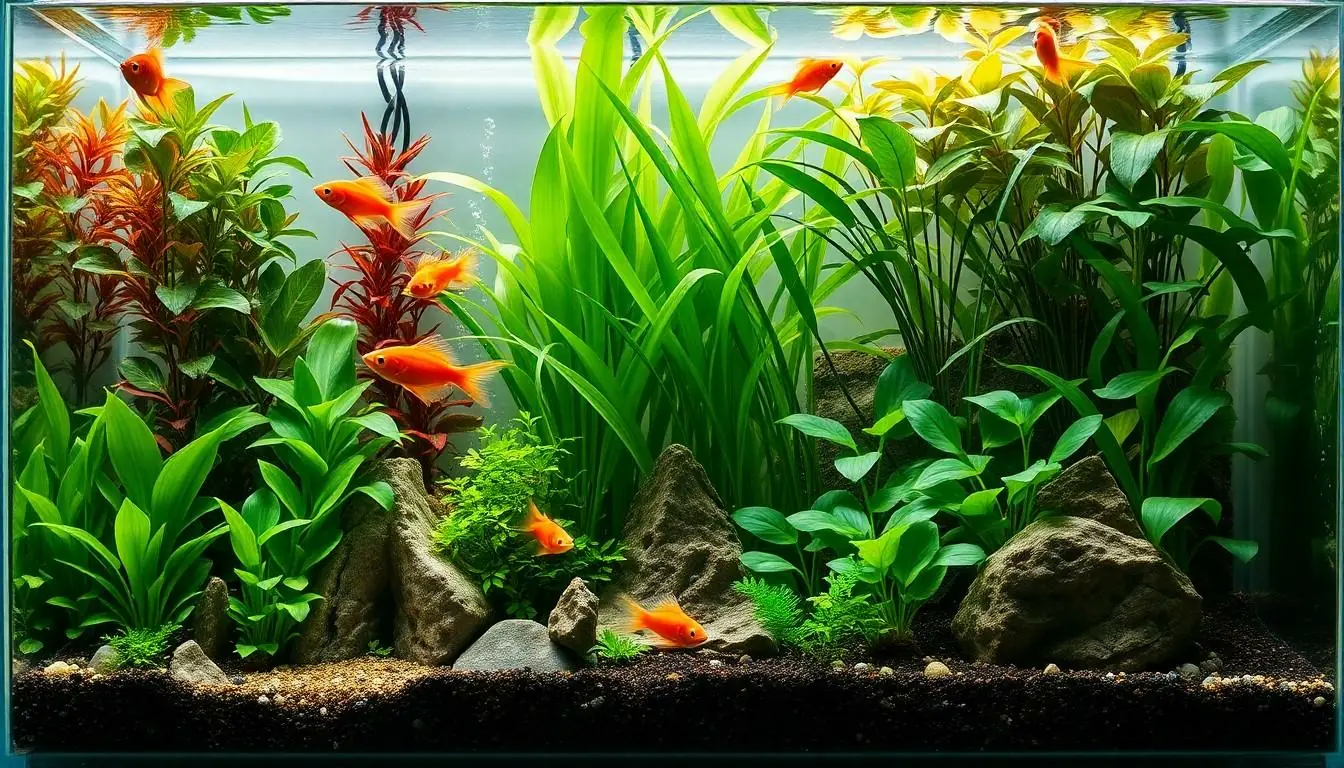Table of Contents
ToggleImagine transforming your living space into a vibrant underwater jungle where fish swim among lush greenery. Indoor house plants in a fish tank aren’t just a quirky trend; they’re a delightful fusion of nature and creativity. This unique setup not only beautifies your home but also creates a mini-ecosystem that benefits both plants and fish.
Who wouldn’t want to impress guests with a conversation starter that’s both functional and fabulous? Picture this: a serene aquatic scene with colorful fish darting through a forest of leafy plants. It’s like a Pinterest board came to life! Dive into the world of aquatic gardening and discover how to create a stunning arrangement that’s sure to make your home the envy of all your friends.
Benefits Of Indoor House Plants In Fish Tank
Combining house plants with a fish tank offers numerous benefits. This setup not only enhances the living space’s aesthetic but also influences the ecosystem positively.
Improved Air Quality
Indoor house plants in fish tanks contribute significantly to improved air quality. They absorb carbon dioxide and release oxygen, promoting a healthier environment. Various plant species filter toxins from the air, which can lead to a decrease in airborne pollutants. Studies show that specific plants like Peace Lilies and Spider Plants excel in air purification. Integrating these plants into an aquatic setting amplifies their benefits, creating a symbiotic relationship that maintains optimal water quality as well.
Aesthetic Appeal
The aesthetic appeal of indoor house plants in fish tanks captivates attention. They create a vibrant and lush underwater landscape that enhances any room’s decor. A diverse selection of colors, shapes, and textures adds visual interest. Combinations of floating and submerged plants create depth, while the dynamic movement of fish complements this beauty. As an engaging centerpiece, these setups spark conversations and become focal points in living areas. The unique blend of greenery and aquatic life fosters a tranquil atmosphere, making spaces more inviting and stylish.
Types Of Suitable Indoor House Plants

Creating a harmonious indoor aquatic garden requires selecting the right house plants. Various plants thrive in a fish tank environment while offering visual appeal and functional benefits.
Low-Light Tolerant Plants
Certain plants excel in low-light conditions, making them ideal for aquariums. Snake Plants, also known as Sansevieria, are hardy and can adapt to different lighting environments. Pothos thrives in low light, providing lush greenery without requiring direct sunlight. ZZ Plants feature glossy leaves and tolerate low light well, adding elegance to any aquatic setup. These plants not only enhance aesthetics but also contribute to a healthier ecosystem, effectively purifying the air while enriching the aquatic surroundings.
Aquatic Plants That Thrive
Aquatic plants play a critical role in establishing a balanced fish tank ecosystem. Anubias grows well underwater and thrives in low-light conditions, making it a favorite among aquatic gardeners. Java Fern supports various fish species while providing natural hiding spots for aquatic life. Amazon Sword, with its broad leaves, adds depth to the tank and benefits from nutrient-rich substrate. Incorporating these plants fosters a vibrant environment and supports the well-being of both plants and fish, ultimately creating a flourishing aquatic garden.
Care Tips For Integrating Plants In Fish Tanks
Creating a thriving indoor aquatic garden requires attention to essential care tips for both plants and fish. Understanding the needs of each component leads to a harmonious environment.
Lighting Requirements
Light plays a crucial role in supporting plant growth in fish tanks. Low to moderate light works best for varieties like Pothos and Anubias. Using full-spectrum LED lights mimics natural sunlight and promotes robust leaf and stem development. Placing the tank near a window provides additional natural light but avoids direct sunlight to prevent overheating. Regularly monitoring light duration should ensure plants receive around 10 to 12 hours of light daily. Adjusting the height of the light source can help accommodate different plant species as well.
Maintaining Water Quality
Maintaining water quality is vital for both fish and plants. Regularly testing water parameters, such as pH and ammonia levels, ensures a balanced environment. It’s essential to perform partial water changes weekly to remove toxins and add fresh nutrients. Utilizing a quality filter can help manage waste while fostering beneficial bacteria. Adjusting the temperature to suit both plant and fish needs supports overall health. Lastly, using fertilizers specifically designed for aquatic plants enhances nutrient absorption, helping them thrive alongside their aquatic companions.
Common Challenges And Solutions
Maintaining an indoor aquatic garden presents challenges. Addressing these issues ensures a thriving environment for plants and fish.
Algae Growth
Algae growth can quickly become problematic in fish tanks. Excessive nutrients in the water, often from overfeeding fish or decaying plant matter, encourage this issue. Additionally, poor lighting can contribute to algal blooms. Regular maintenance, including partial water changes and effective filtration, prevents nutrient buildup. Reducing light exposure to 10-12 hours daily also limits algae proliferation. Using aquatic plants like Java Moss absorbs excess nutrients and competes with algae for resources. Encouraging a balanced ecosystem keeps algae levels in check.
Plant Health Issues
Plant health issues commonly arise in indoor aquatic gardens. Root rot occurs when plants sit in overly saturated soil or water. Ensuring proper drainage and using suitable substrates helps mitigate this risk. Inadequate lighting can weaken plants, causing yellowing leaves. Providing low to moderate full-spectrum light meets the needs of most indoor house plants. Pests such as aphids and spider mites may invade, so regular inspections detect infestations early. Addressing these problems with appropriate treatments maintains robust plant health. Keeping dead or decaying leaves removed promotes growth and prevents issues from escalating.
Integrating indoor house plants into a fish tank creates a stunning and functional aquatic garden that enhances any living space. This unique setup not only beautifies interiors but also promotes a healthy environment for both plants and fish. By choosing the right species and maintaining optimal care, anyone can cultivate a thriving mini-ecosystem that captivates the eye and sparks conversation.
With the right balance of lighting and water quality, the vibrant colors of plants and the graceful movement of fish can transform a simple tank into a breathtaking centerpiece. Embracing this creative approach to gardening allows individuals to enjoy the benefits of improved air quality while fostering a serene atmosphere in their homes.




